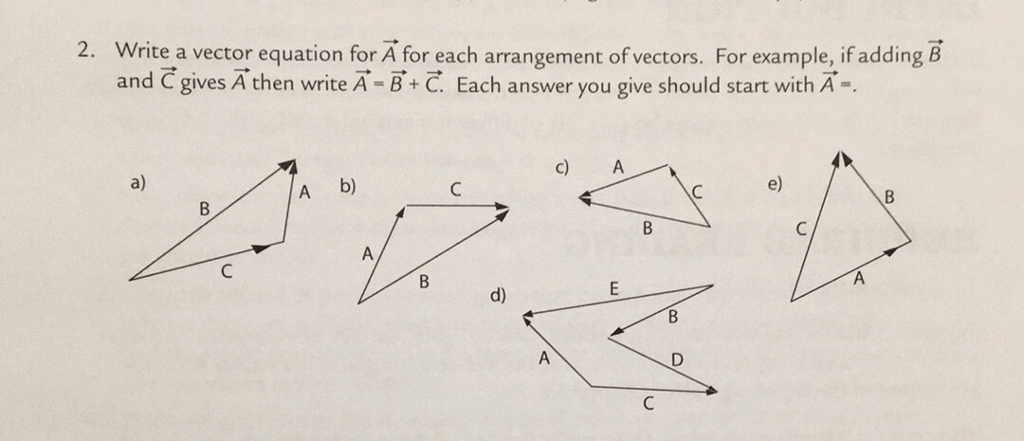Vectors Homework Help
Vectors Homework Help and Vectors Definition
A vector is a ray with both magnitude (size) and direction. A vector is
different from a scalar in that a scalar has only magnitude. For example,
speed is a scalar quantity, but velocity is a vector, because it gives both
speed and direction. Vectors are used to show directed quantities, and can
be thought of as the motion necessary to get from one point to another.
Vectors are typically written as a, or
![]()
Vectors are numbers that have both magnitude and direction. A car has a velocity of 30 m/s in the south direction is a vector. There is a magnitude describing the value and a direction describing the motion. Vectors are used to describe 2 and 3-dimensional motion.
A Vector is a geometric object that has both magnitude and direction. A Scalar on the other hand just has magnitude.
Vectors are a wonderful tool in Vectors and Maths. They have a few different
components.
A vector has both a magnitude (which is usually shown through the length of
the vector) and a direction (where it's pointing). Velocity, for example,
is a vector. Velocity, unlike speed, has a magnitude and a direction.
The direction of a Vector can be broken up into components across your axis
in both 2-dimensional and 3-dimensional space.
For instance, if a velocity vector is in 2-dimension and pointing entirely
horizontal in the positive direction, it's x component would be its
magnitude, and its y component would be 0. If it was at some angle between
0 and 90 degrees, it would have a positive component of both x and y that
Vectors examples
speed is a scalar: I am driving at 10 miles per hour. You know you are
moving at a speed but you do not know which direction you are moving.
velocity is a vector: for example, I am driving at 10 miles per hour in the
north-west direction. This is an example of a vector as we know how fast we
are going and in which direction we are going.
Mathematically,
the modulus of a vector, gives you a scalar which has the same magnitude as
the vector.
Also, a 2d dimensional vector(x i + y j ) means that the vector as a
magnitude x in the 'i' direction and a magnitude 'y' in the j direction.
The total or scalar magnitude of the vector is given as √(x2 + y2).
Properties of Vectors
Mathematical objects that have both the magnitude and direction are termed
as “Vectors”, which is represented like an arrow. The algebraic
representation of vectors is nothing but to perform easy computations.
These calculations include addition and scalar multiplication of vectors.
For any vectors
![]()
1. Commutative property of addition:
![]()
2. Associative property of addition:
![]()
3. Distributive property over vector addition:
![]()
![]()
4. Additive identity:
![]()
5. Additive inverse:
![]()
6. Distributive property over scalar addition:
![]()
7. Associative property for scalar:
![]()
8. Multiplicative (scalar) identity
:
![]()
Examples of Vectors
![]()

Write a vector equation for A for each arrangement of vectors. For example, if adding B and c gives A then write A -B+ C. Each answer you give should start with A- 2. C) A A b) e) d)"
(a)
Example 3
A = 1.01 i + 4.75 j
B = 2.79 i + 3.77 j
So, A + B = (1.01 + 2.79) i + (4.75 + 3.77) j
A + B = 3.80 i + 8.52 j Thus, magnitude of (A+B)
= √(3.802 + 8.522) = 9.329
Thus, R = 9.329
Angle = atan(8.52/3.80) = 65.962 deg
Example 4
given vectors are (25,12,21) and (-2,2,6)
If two vectors are (x1,x2,x3) and (y1,y2,y3) then the distance between two vectors is given by formula
Distance = √ [(x1 - y1)2 + (x2 - y2)2 + (x3 - y3)2]
So, Distance = √ [(25-(-2)) 2 + (12-2)2 + (21-6)2]
= √ (729+100+225)
= √ (1054)
Example 4: Vector addition using the component method
vector A = -Acos45 i + A sin 45 j
= -424.26i + 424.26 j
vector B = Bj= 500j
vector C = C cos45 i- Csin 45j
C= 282.84i - 282.84j
resultant = vector A+vector B+vector C
= (- 424.26+282.84 ) i +(424.26 + 500 -282.84 ) j
= -141.42 i + 641.42 j
magnitude of resultant = √[(-141.42)2+(641.42)2]
= 656.83 m
the resultant force is as shown
tan θ= 641.42/141.42
θ= 77.57o north of west
- Physics - Vectors
- Physics - Newton law of cooling
- Physics - Atomic Physics
- Physics - Circular Motion
- Physics - Properties of matter
- Physics - Electromagnetics
- Physics - Gravitation
- Physics - Kinematics

